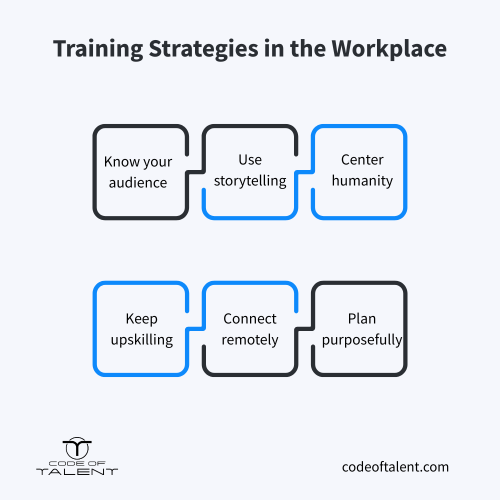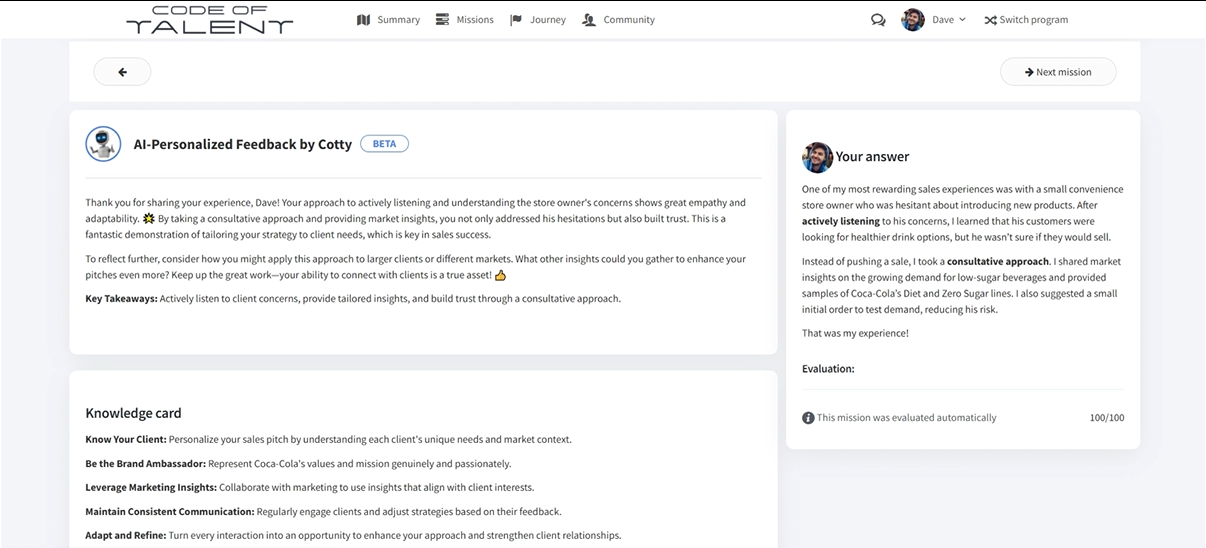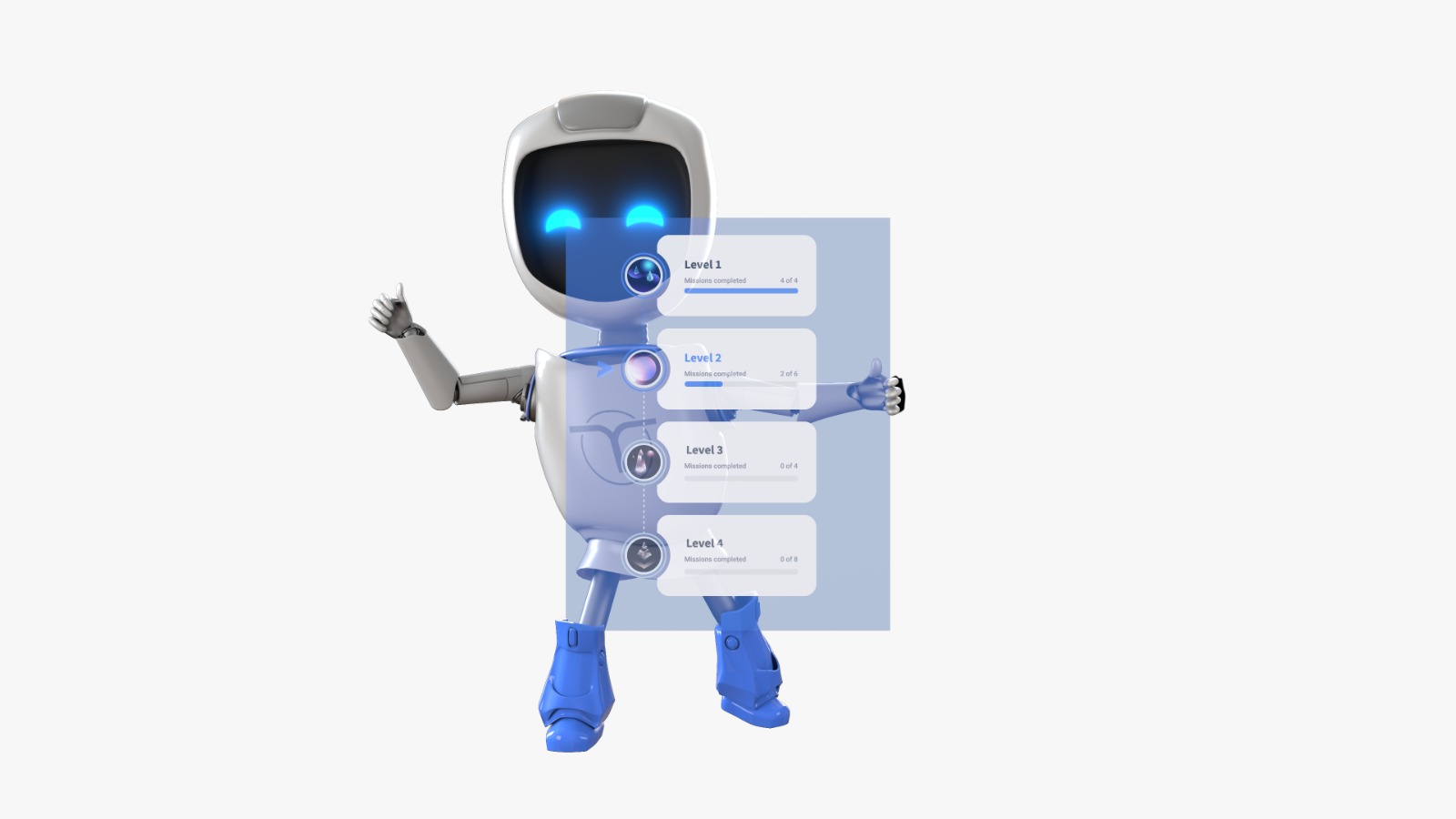As we explored in our previous piece, AI isn’t replacing learning and development (L&D) professionals, especially training facilitators, but it’s indeed transforming their roles. In this context, a new question emerges: how to be a good trainer when AI is taking over the workplace?
In a 2023 Gallup survey, 72% of top CHROs said they believe AI will replace jobs within the next three years. At the same time, 65% were optimistic about AI’s ability to improve performance across roles. That duality captures where we are: hopeful, but cautious. Meanwhile, at the 2024 Davos conference, Hadi Partovi, founder of education nonprofit Code.org, made a compelling point: the real risk isn’t that AI will take your job, but that someone else who knows how to use AI will.

In L&D, this shift is already happening. AI can draft training programs outlines, design assessments, and even tailor content to different roles. But while the tools are new and plenty, the heart of learning remains the same: people. So how can you evolve as a trainer, without losing your impact?
Let’s talk about how to be a good trainer in this new era and remain relevant even in the face of change. This article is addressed to training facilitators and instructors, especially for those who work for corporate clients.
Table of Contents
Good vs. Great Trainer in the Context of AI
With AI collecting, analyzing, and storing vast amounts of information, how much one knows is no longer the main differentiator in L&D. What truly sets professionals apart is how well they connect. While AI can handle content delivery, it lacks the empathy, energy, and awareness of a person. This is where human trainers come in: they bridge the gap between technology and the learner.
Here’s what separates great trainers from the rest:
- Good trainers deliver information. Great trainers drive transformation.
- Good trainers follow frameworks. Great trainers adapt in real time.
- Great trainers link training to both individual growth and organizational change.
The Key Skills Every Great Trainer Must Master
With every technological advancement, people must adapt and adopt new or existing skills. Here are some fundamental areas facilitators should focus on to stay relevant in an AI-driven world.

Know How to Deliver Your Message
With the right words and delivery, even the most complex concepts are easy to understand. No matter the training content—whether it’s delicate communication exercises, complicated pharma product knowledge, or lengthy and overwhelming compliance and risk assessments—a skilled trainer knows how to present information in a clear, accessible way.
As TrainingMag puts it, the nuance of delivery can matter more than the message itself. A warm smile, a well-timed joke, simple yet powerful language, or animated gestures can turn a dull session into an engaging learning experience rather than just another time-consuming task.
Tip: Use AI tools to simulate role-playing exercises and deliver various types of training content. It’s a great way to practice and build confidence, without the pressure of being judged by others.
Adapt to New Technologies
The era of PowerPoint presentations is slowly fading as new technologies reshape training. Mobile-friendly apps, microlearning, and virtual reality tools now offer flexible, engaging learning experiences. According to SkyQuest, e-learning now leads as the most common training method (used by 80% of companies), followed by instructor-led training (60%) and webinars (50%). A great trainer stays up to date with these advancements and knows how to use them effectively.
Tip: Make use of free trials from various training platforms to explore their features and determine which best suits your needs. For example, Code of Talent offers a free trial that allows you to build AI-driven training programs tailored to a wide range of needs.
Learn How to Offer the Right Feedback
Feedback is one of the most important tools in a trainer’s toolkit. Methods like the Sandwich technique (shown to increase learner engagement and performance) or the SBI Model (Situation-Behavior-Impact) offer structure and clarity. A skilled trainer understands the variety of feedback approaches and knows when to use each based on the situation.
Tip: Use as many feedback methods as possible and evaluate the learners’ responses to each. Which methods were most effective? Which sparked unwanted reactions?
Gain Confidence with AI Tools
According to Deloitte’s 2024 GenAI report, projects have suffered delays because of people’s reluctance to GenAI adoption (mainly from skill gaps). While AI tools are often easy to use, it still takes time for people to get used to new technologies.
That’s why digital fluency, especially in working with AI, is crucial. As CNBC reports, prompting AI effectively is quickly becoming a foundational skill in today’s workplace. From drafting content to generating ideas, AI can increase productivity, if one knows how to use it. Building confidence with these tools is now essential for modern trainers and learners alike.
Tip: In your spare time, practice your prompting skills using free AI tools like ChatGPT or Gemini. Save your most effective prompts in a dedicated folder for easy access.
Use Strategic Communication for Better Visibility
Good communication is not only limited to the learners, but to the management and leadership as well. Keep team leaders consistently updated on their team’s training performance, and provide upper management with actionable insights about company-wide training programs. Being able to advocate for your learning initiatives and measure their impact builds both credibility and visibility.
Tip: Schedule regular check-ins with team leaders to discuss their direct reports’ progress. Team leaders value feedback and initiatives that support the development of their team’s skills and performance.
How to Be a Good Trainer in the Workplace
Let’s face it: most people aren’t exactly jumping at the chance to attend training. For many, it’s just another task to check off because HR said so. And with AI on the rise, this disengagement could grow even further.
That’s why creating an engaging learning environment is at the heart of how to be a good trainer. Below are a few actionable steps to help you build that kind of environment, while keeping AI’s role and influence in mind.

Understand Your Audience
You can’t sell meat to vegetarians—just like you can’t train an experienced IT support specialist on the basics of Microsoft Office. They’d think you’re wasting their time, or worse, insulting their expertise. Knowing your audience is key to delivering a relevant and effective training program.
Start by segmenting your audience based on:
- Job role
- Skill level
- Learning goals
- Motivation
Use short surveys to gather learner input. Then, use that data to personalize learning paths and match pacing with performance. Training should drive behavior change, not just attendance.
Use Storytelling in Training
There’s a reason why movies, TV series, and books stick with us even after a long time. Storytelling gives people reasons to relate and root for people, situations, and values. In training, storytelling makes learning more memorable and emotionally impactful.
Here are some ways to introduce storytelling into training:
- Use a GDPR case study video to highlight the real cost of non-compliance.
When learners see how small mistakes can lead to multi-million-dollar fines, they’re more likely to take data protection seriously. - Simulate a scam phone call during cybersecurity training.
Turning learners into active characters in a scenario helps them feel the urgency and teaches them how to respond in real life. - Pose ethical dilemmas in healthcare through interactive quizzes.
These situations spark conversation and critical thinking as participants explore the best approaches to complex problems. - Share real stories from experienced managers.
Hearing that even leaders have struggled builds confidence in new managers and reminds them that growth is part of the journey.
Double Down on Human-Centered Skills
According to People Management, the complexity of emotions, context, and culture is still far out of reach for machines. To stay irreplaceable, trainers should invest in:
- Emotional intelligence
- Cultural fluency
- Empathy and active listening
- Reading group dynamics
- Narrative thinking
These are the muscles that define a human-centered trainer. No AI can truly read facial expressions and adapt in real time based on human reactions, nor can it intuitively choose the right tone of voice for a given situation.
Stay Curious and Keep Upskilling
It’s often said that as long as we live, we learn. And in today’s chaotic workplace environment, with new trends and technologies emerging every day, upskilling has become a differentiator between those who excel and those who stay behind. According to PwC’s 2024 Workforce Hopes and Fears report, 45% of workers have had to learn new technologies, with many also seeing their job roles shift.
So, what does upskilling mean for a good trainer?
- Stay current with digital tools, facilitation styles, and behavioral science.
- Ask learners and peers for feedback and identify areas for growth.
- Read industry publications (books, magazines, studies, or surveys) in L&D.
Facilitate Real Connection in Hybrid and Remote Environments
Remote learning has changed how we interact. One study found that collaboration networks became more rigid and isolated, with less connection across different teams, and a recent survey found that 25% of remote workers say their social skills have declined. It’s clear that, in the context of hybrid or remote working, the need for a more collaborative learning experience is higher than ever.
Here’s how to include collaborative learning into training:
- Add micro-interactions (quizzes, polls, open-ended reflections) into every session.
- Create space for real conversation, not just content delivery.
- Start every session with an icebreaker. While some participants may find them awkward, icebreakers are an easy way to spark engagement from the beginning.
- Use platforms that support collaborative learning, with features like commenting on others’ progress, joining discussions on key topics, and participating in team-based challenges. Microlearning platforms are especially effective, as their collaborative tools make training more engaging.
Adopt Strategy into Your Process
A literature review in the International Journal of Research in Commerce and Management Studies shows that learning drives engagement, retention, performance, and strategic alignment. Recognizing training as a strategic investment drives business outcomes and shows your value as a key player.
To make this shift:
- Ask: “What’s the business outcome behind this request?”
Start with the “why” behind any training task. Clarifying the goal keeps your efforts aligned with business priorities. - Use data to show how learning ties to KPIs.
Metrics matter. Show how your programs impact performance, productivity, or retention to gain credibility. - Present yourself as a partner, not just a provider.
Show that you’re not just there to “run a training.” You’re there to help the business move forward. That shift in mindset changes how people see your role.
Embrace AI as Your Co-Pilot
AI can’t replace you, but it can help you work smarter. Think of it as your behind-the-scenes teammate, taking care of the repetitive tasks so you can focus on what truly matters: people.
Generate Course Outlines in Minutes
Get a head start with AI-drafted structures based on learning goals, audience level, and topic area. You can customize and edit these outlines to match your training style or organizational tone afterwards. It’s a time-saver that helps you move from idea to implementation much faster, without starting from a blank page.
Analyze Learner Feedback to Spot Trends
Instead of sifting through dozens of responses or surveys manually, let AI highlight patterns: what’s working, what’s not, and where you can improve. AI can analyze large volumes of feedback in seconds, identifying key trends and common themes and allowing you to focus on actionable insights.
Simplify Reporting and Training Data Analysis
AI can quickly turn raw data into clear, visual reports, highlighting learner progress, completion rates, skill gaps, and overall program impact. No more digging through spreadsheets or wasting time in drafting reports.
Make Use of Virtual AI Assistants
Some training platforms now include built-in AI assistants that:
- Provide real-time feedback on learners’ responses
- Track engagement
- Auto-suggest follow-ups
- Recommend course changes in real time
These virtual AI assistants are designed to take the heavy lifting off your plate—handling tasks like data, automating routine work, and providing templates for feedback. This lets you focus on what AI can’t do: maintaining the human touch.
Scale Human Impact with a Smart Platform
If you’re ready to scale your human impact with the support of intelligent tools, Code of Talent is designed for the modern trainer. Its features include:
- Microlearning
- Adaptive learning paths
- Real-time learner analytics
- Gamification
And because the platform is built for hybrid work, it includes features that encourage interaction, conversation, and connection, even across screens.
Innovative Virtual AI Trainer
In addition to the features listed above, Code of Talent has introduced a new virtual AI assistant to help trainers focus on what matters most. Its main job is simple: analyze participant responses and provide instant feedback. While you can always review and adjust the feedback as needed, it saves you time by generating responses in under 10 seconds. It’s the partner every trainer needs to stay essential in an AI-powered world.
See it in action:

Your Turn
Knowing how to be a good trainer in today’s world means blending technology with the very human skills AI can’t touch, like empathy, adaptability, and connection. Code of Talent gives you the support to do exactly that. From AI-powered feedback to collaborative microlearning, it’s the platform built to keep trainers essential.





